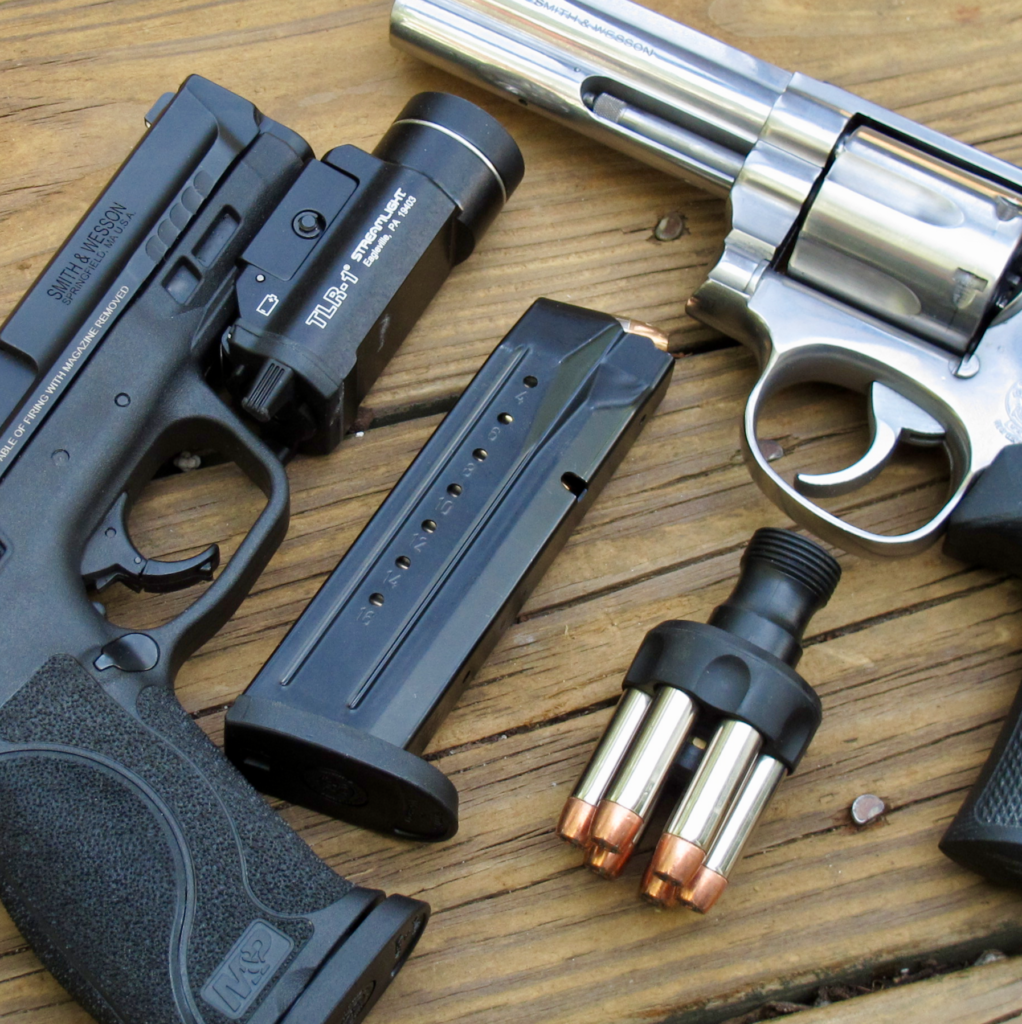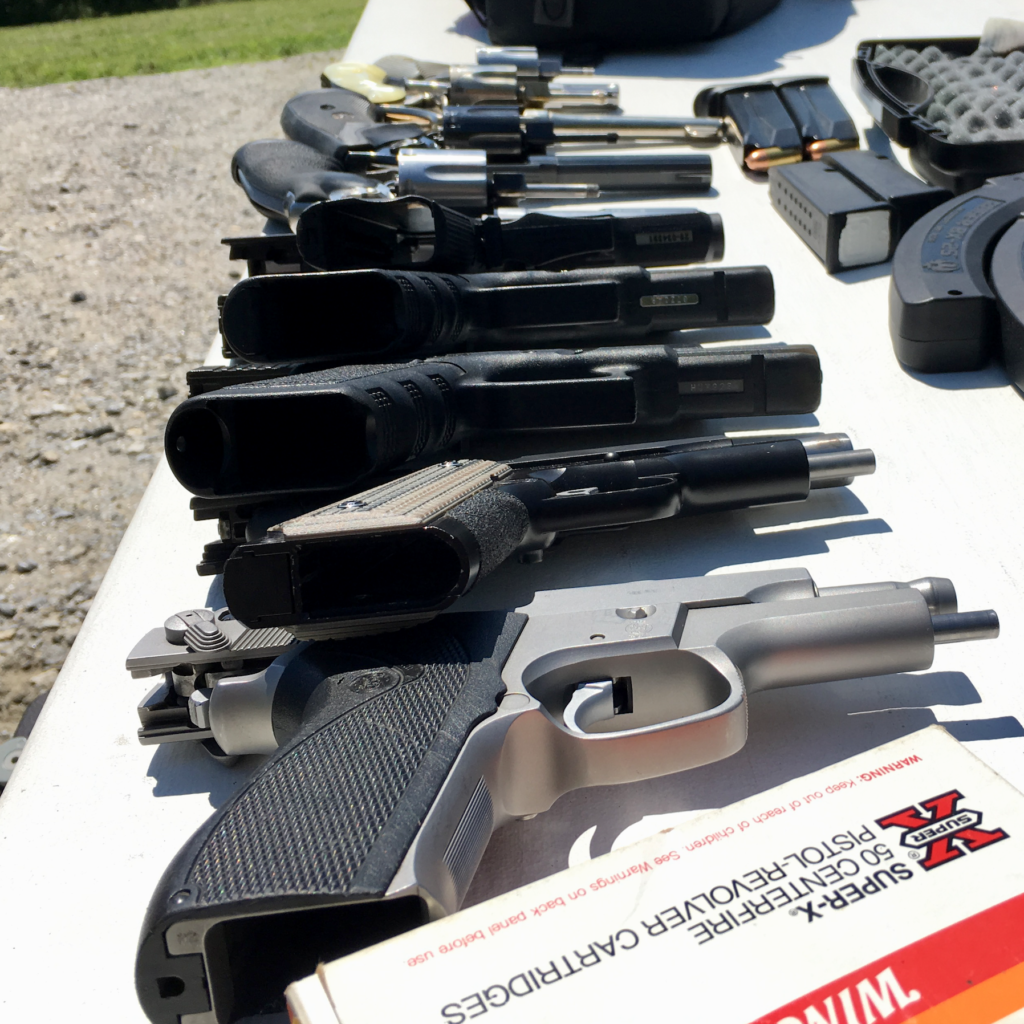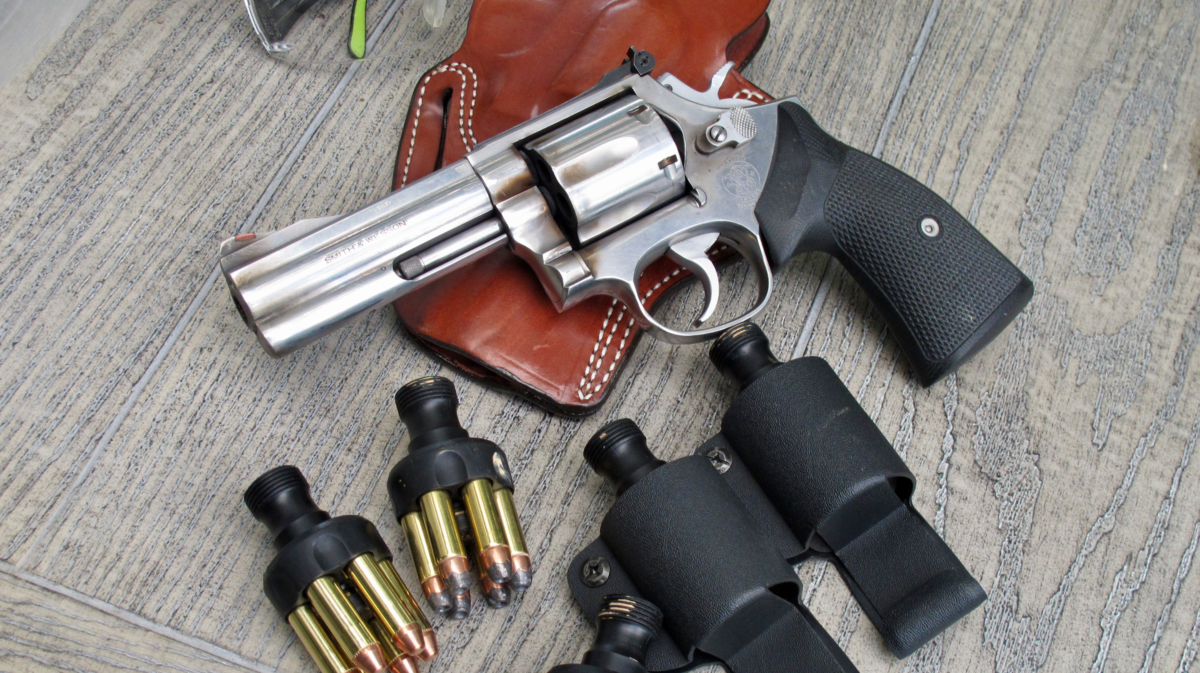I frequently get the question, “why revolvers?” Using revolvers doesn’t make much sense to some, especially in today’s world of inexpensive, reliable, high-capacity semi-autos. However, I still contend that gun owners should be well rounded. This means that you – yeah, YOU! Over there with the HK V-whatever – should know how to operate a revolver proficiently. This post will probably mostly be preaching to the choir, but that’s OK – it might help you to answer the, “why revolvers?” question. My real hope is that you will direct the asker of that question here, so I can explain!
I further hope that this post will veer from the well-worn “revolvers vs. semi-autos” path. I’m not going to debate reliability, capacity, or any of the other dogs and ponies that normally get trotted out in these forums. Instead, I hope to offer some reasons for revolvers that even those diehard 1911 shooters and Glock fanboys can sink their teeth into. Let’s begin, shall we?
Educating Friends and Family
There are millions of revolvers in the world. “Modern” double-action revolvers have been manufactured for 100+ years. Many of these old-timers are still doing duty in a nightstand drawer. It is doubtful to the point of impossibility that all of these old revolvers are paired with an owner that is equal to their capability. Meaning, in a nutshell, there are a lot of people out there with revolvers that have no idea how to use them.
Enter the RevolverGuy. Even if you’re not a RevolverGuy (and instead, just a run-of-the-mill gun guy) you’re probably THE gun guy in your family, at your job, and within your larger circle of friends. Odds are good that one of those friends, family members, or your buddy down at your office, church or bowling alley has a revolver lurking at the top of the closet…that they don’t know how to use. If they come to you and ask, “how do I use this thing?” you should be prepared to show them.
Even if they don’t ask, maybe you should invite them to the range. If they show up with an old Model 10, they’d probably prefer you didn’t look down your nose and try to sell them on your hardware and instead, show them how to run theirs! And while we’re at it, they probably need some help selecting support equipment, too. With a little range time under your good instruction, a decent holster, some good ammo, and maybe a speedloader or two and you can take someone from “I have a gun somewhere around here” to a pretty capable home defender. That’s an awesome feeling!
Training: Trigger & Dry Practice
Revolvers have a number of tremendous training benefits – even if you don’t plan to use revolvers competitively, defensively, or for hunting. Skill with a revolver can translate to even more skill with other, easier-to-shoot handguns.
Chris Baker over at Lucky Gunner did an entire article on the benefits of the double action revolver’s trigger. The DA trigger is both longer and heavier (we do call it a double action for a reason – please stop shooting it in single action!) than your striker-fired or SA autos. You might consider this a bad thing for daily carry or defensive use. You shouldn’t consider it a bad thing for range time, though. If you can master the act of manipulating the very long, 10 to 12-lb double-action trigger of a revolver without moving the sights, you’ll be amazed at what you can do with your short-triggered semi-autos. You can consider all the time you spend shooting revolvers to be “semi-auto appreciation” sessions.
Another major advantage of revolvers is that they allow you to dry practice without pausing to reset the trigger. This lets you work on multiple-shot engagement in a way that semi-autos are incapable of (at least without investing in some sort of training trigger). Dry practice is massively important, and even though I carry an autoloader, I spend a lot of my dry practice time with a rotator. Just remember, if you’re dry practicing a lot, you should probably have a few snap caps on hand.
Training: Ball-and-Dummy Drill
When I attended Chuck Haggard’s Practical Revolvers I learned one of the coolest things I’ve learned in a long time: how to do ball-and-dummy with a wheelgun. In case you aren’t familiar, the ball-and-dummy drill involves presenting your handgun and manipulating the trigger without knowing whether or not a round is present in the chamber. This helps to shooters to focus on effective, smooth trigger manipulation. It also reveals, and can help to correct, anticipatory flinching. With semi-autos it is somewhat difficult to do ball-and-dummy without a training partner to load/unload your firearm for you.
Again, this is a good use for snap caps (distribute them randomly through the magazine), but the revolver does it better. Here’s how to do it: First, load the revolver to capacity. Next, fire a shot. Open the cylinder and spin it. Arrest the cylinder’s spinning, close it without looking, and readdress the target. You will get a fairly random mix of “clicks” and “bangs.” Occasionally you will get several “clicks” before the hammer falls on a live round, and occasionally you will get several live rounds in a row.
If you’re not shooting a revolver at all, you should. When Mike Seeklander hosted me on the American Warrior Show he said that he finishes all his range sessions with a GP100 Match Champion because of the training benefit offered by the DA trigger. Seeklander is quite the accomplished professional shooter, so I don’t take his advice lightly.
Near Universal Legality
Revolvers are perhaps the “most legal” handgun you can own. If there is a chance you may move to or visit a more restrictive jurisdiction, a revolver might be right for you. There are no revolvers (that I’m aware of) that break the commonly-accepted “high capacity” ceiling of 10 rounds.

This is actually pretty helpful to me at times. When I have to travel (and I travel a LOT) to or through jurisdictions where hi-cap magazines would put me afoul of the law, guess what? That’s right – I have a perfectly capable weapon that doesn’t take any magazines at all. Incidentally, revolvers may also look less threatening to some than a Glock or other soulless plastic pistol, in the same way a Winchester Model 94 may be perceived as less threatening than a tricked-out AR. That last part won’t put you square with the law, but it might help around gun-sensitive individuals
Being Well-Rounded
When I show up at a match, shooting course, or the shooting range with a revolver, I get a warm feeling. That feeling comes from knowing that I could trade guns with anyone there – from 1911 to Beretta to Glock – and run that gun pretty well. I also know this feeling is not reciprocated. Most of today’s handgunners can get a revolver to make noise, but to say they could “run” it would be pretty optimistic. Being a well-rounded shooter necessarily means being able to run a revolver.

Why should you be well-rounded? I can revert back to point #1 about being able to educate your friends, family, neighbors, whomever. And that is an important point. Co-morbid with that reason is this: there are millions of double-action revolvers in this country. I doubt I’ll ever find myself in a battlefield recovery situation where I’m picking up someone else’s revolver. However, I may be called to help someone out who’s kid has “discovered” a revolver, and I probably need to know how to safely unload it. The jokes about rookie cops (to say nothing of regular Joes) these days that don’t know how to open a revolver’s cylinder. . . aren’t jokes.
The Bottom Line
Even if you aren’t a RevolverGuy – heck – even if you hate revolvers, you should probably have one and know how to use it. It will make you a better shooter. It will allow you to make others better shooters, and it will round out your education as a shooter. So if you don’t own a revolver, maybe think about getting on. And if you have one that hasn’t gotten much range time lately, take it out and warm it up!


Glad the comments seem to be working.
Regarding this topic…For some time, my wife and I are helping a friend test-fire a BUNCH of rental semis; we’ve fired nearly 500 rounds through Walthers, Glocks, S&Ws, Rugers, Sigs and a few more I forget.
Our friend lives by herself, and she had her mind set on a modern, full-sized 9mm home-defense gun, my least favorite of handguns, though I do shoot them well. My wife hates working a slide, so 4 of our five handguns are wheel guns. That said, we were not choosing, and shooting polymer 9s was a great ego-booster. We shot the shucks out of them.
To our surprise, our friend called to tell us that she has decided on a full-sized revolver. She’s still shopping. Her reasoning? The DA triggers are just right to avoid nervously squeezing off a shot, something she did with every semi (of about 10) we shot, despite (to my eyes) her employing good firearms handling. She would get ready to fire and the gun would surprise her too often. Adrenaline in a competitive person does that. I train to be relaxed with the weapon, and that’s hard to master.
It’s something to consider, accidental shootings being the very reason that DA triggers were made heavy out of the factory in the first place.
That’s certainly one of the things that makes a DA revolver shine. It’s wonderful that your friend figured it out for herself–it will mean so much more than if you had just told her. Kudos to you and your wife for guiding her through the process like that. I’m sure it was an immense help, and now she’ll wind up with a good fit, instead of whatever the clerk at the store wanted to push on her.
Yep. Guys lined up to “gunsplain” the “best” (which means their favorite) weapons to a woman! I kept grinning when one guy INSISTED that a 1911 in 9mm was the best handgun ever made. Another said “All Glock 19s all the time” and a third sang the praises of the PPQ’s light and smooth trigger (my favorite 9, but with precisely the problem that our friend wanted to avoid). I kept my mouth shut, because I would have picked the M&P 2.0. I liked the texture of the grip, but that texture was our friend’s LEAST favorite.
Now she can get an aftermarket grip, with laser if she wants, that best fits her hand. I’m thinking a S&W 64 LE trade-in would be a candidate. We own one with a 4″ barrel and she shoots it really well. But we’ll just line up the wheelies and let her shoot the lot.
Never have a favorite weapon. Musashi Miyamoto
I am reminded of musings attributed to the late, great Gen. George S. Patton, Jr., when the subject of his two carry revolvers ( specifically the ivory grips on his Colt .45 SAA and S&W .357 ) was once brought up. He is alleged to have quipped something to the effect that all you need to do is feed him loose ammunition and his revolvers will continue to fire.
His observation was in stark contrast to the U.S. M1 Garand that was quite useless without the en-bloc clip for ammunition feeding, and the fact that every other small arm in the U.S. inventory (except the 1903A3) required a removable magazine to be of any use.
There’s a lot of truth to Gen. Patton’s logic . . . especially with Ruger single actions. I’ve never had the ‘magazine’ on a Colt, S&W, or Ruger revolver go bad and need replacement.
Really late, but just wanted to give you a bit of trivia. There is one revolver in current production that exceeds 10 rounds. As a Californian, this single-action (!) revolver is illegal for me to own: the 12-shot Uberti 1873 Cattleman in .22 LR. One of my local gun shops even did the research and confirmed it is illegal in CA even though it is single-action.
https://www.uberti-usa.com/1873-cattleman-22-revolver
Ha! Very interesting, thank you for the heads up!